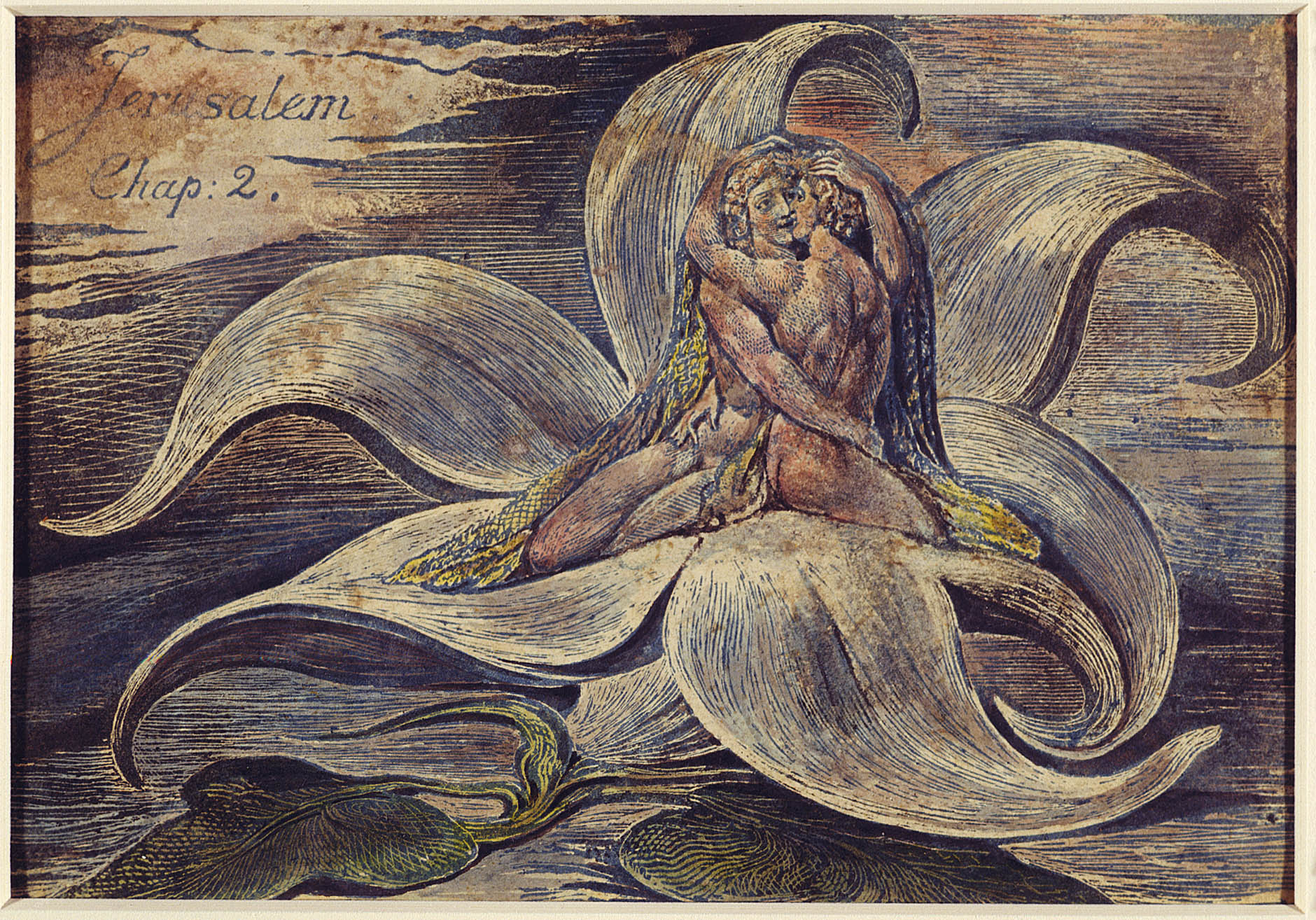The William Blake Archive is pleased to announce the publication of digital editions of Jerusalem The Emanation of The Giant Albion Copy A, from the British Museum, and Copy I, from the Rosenwald Collection, Library of Congress. In addition to these two copies, the Archive is publishing thirty-one miscellaneous impressions of Jerusalem.
Jerusalem, Blake’s masterpiece in illuminated printing, comprises 100 relief and white-line etchings, divided into four chapters, executed between c. 1804 (the date on the title page) and 1820. It constitutes a recapitulation and summation of his multiple interests, ranging from his own mythology to biblical history, from sexuality to epistemology, and from the Druids to Newton. The cast of characters is vast, but Los (the artist’s imagination at work in the material world), Jerusalem and Albion (the female and male portions of divided humanity who must be reunited), the nature goddess Vala, and Jesus play major roles. Each of its four chapters is addressed to a different audience: the Public, the Jews, the Deists, and the Christians. Jerusalem concludes with a vision of human consciousness in a post-apocalyptic universe. Portions of The Four Zoas, Blake’s long manuscript poem, are repeated (often with little revision) in Jerusalem.
Sixty plates may have been completed by 1807; a few examples were exhibited in 1812. Copy A was produced in 1820 along with copies C and D. In the next year, Blake printed Copies B (chapter 1 only, Plates 1-25) and E, the only copies he colored. He printed Copy F in 1827 but left it uncollated on his deathbed. Copy I is one of three posthumous copies of Jerusalem, all printed in reddish brown on paper watermarked 1831 and/or 1832 by Frederick Tatham, who obtained the copperplates of Blake’s illuminated books after Catherine Blake died in October 1831.
There are two arrangements of the plates in chapter 2, first (Copies A and C) and second (Copies D and E). Copy F was collated by John Linnell, who used his own Copy of Jerusalem, Copy C, as the model. Erased numbers on the Copy F impressions, however, indicate that Blake intended to order chapter 2 in the second order, which is its order in the Archive. Copy I and the other posthumous copies also follow the second order.
Jerusalem Copies A and I join copies E and F already in the Archive. With Copy A, the Archive now presents Jerusalem in both of Blake’s plate orders; with Copy I, the Archive presents its first posthumous copy of an illuminated book. Posthumous copies of illuminated books (of Songs, America, Europe, and Jerusalem) are part of Blake’s reception history in the first part of the nineteenth century. They are also important bibliographically because they accurately reveal the copperplate designs and texts, usually more so than lifetime impressions, which were often printed without plate borders and finished in watercolors, with texts touched up and even altered in pen and ink.
In addition to Copies A and I, the Archive is publishing thirty-one proofs, impressions in different states, posthumous impressions, and lifetime impressions of Jerusalem not used in copies of the work. These loose impressions form a new category of graphic works, referred to in the index of copies as “MPI,” an abbreviation for Miscellaneous Plates and Impressions. As a group, MPIs reveal Blake’s creative process as it unfolded through production, providing insights and new information about designs and texts. For example, the impression of the Jerusalem frontispiece from the Fitzwilliam Museum (Object 1) is the only impression where the entire text is legible. Blake printed it carefully and clearly and outlined the letters on the impression in pen and black ink; in all published impressions, the text was filled in with printing ink and did not print.

Jerusalem‘s MPIs can be accessed like plates in copies of Jerusalem and compared with impressions from the same copperplate using the “Objects from the Same Matrix” feature in the second navigation bar below the image. The Archive will gradually publish groups of miscellaneous plates and impressions for each illuminated book (some groups consisting of nearly fifty impressions), which will enable users to trace the evolution of Blake’s printed designs.
The Archive now contains fully searchable and scalable digital editions of 109 copies of Blake’s nineteen illuminated books. Users may view color corrected digital images of Blake’s works at their true size, and enlarge and rotate these images to examine texts and illustrations in detail. The images are accompanied by diplomatic transcriptions and editors’ notes, as well as illustration descriptions that make it possible to search Blake’s works for visual motifs. The Archive also provides full bibliographic and provenance information for each digital edition it publishes.
As always, the William Blake Archive is a free site, imposing no access restrictions and charging no subscription fees. The site is made possible by the University of North Carolina at Chapel Hill with the University of Rochester, the continuing support of the Library of Congress, and the cooperation of the international array of libraries and museums that have generously given us permission to reproduce works from their collections in the Archive.
Morris Eaves, Robert N. Essick, and Joseph Viscomi, editors
Joseph Fletcher, managing editor, Michael Fox, assistant editor
The William Blake Archive
